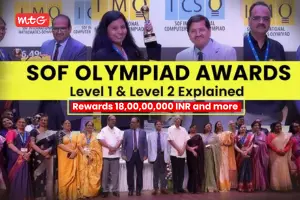Here is the SOF NSO Level 2 sample paper for Class 4 and solutions for each question. Practicing this sample paper multiple times will help students recognize the most important topics for the exam. With a total no of 10 questions to practice, It will help to enable and identify strengths and weaknesses, allowing them to focus more on weaker areas to perform well in the upcoming NSO Level 2 exam. To access the NSO Class 4 sample paper, use the link provided below to enhance your exam preparation.
NSO Level 2 Sample Paper for Class 4
Find the Answers below….
Recommended NSO Study Material
The NSO study material includes the curriculum syllabus of ICSE/ISC, CBSE, and State Boards. To excel in NSO exams, students should be familiar with the syllabus of all three boards for class 4 students. In addition to the curriculum followed by the boards, there are various NSO study materials available for students to study from.
- Class 4 NSO Power Pack – Level 2
- Class 4 NSO Power Practice Pack – Level 2
- Class 4 NSO Olympiad Online Classes – Level 2
- Class 4 NSO All India Online Mock Test Series – Level 2
- Class 4 NSO Olympiad Skill Development System (OSDS) – Level 2
- Class 4 NSO Previous 4 Years Papers (Instant Download eBook) – Level 2
SOF Level 2 Exam Schedule
The second level Olympiads will be conducted on Sunday 11th February 2024 as per the following schedule:
| EXAM | TIMINGS |
|---|---|
| SOF International English Olympiad | 9.00 am to 10.00 am |
| SOF National Science Olympiad | 11.00 am to 12.00 Noon |
| SOF International Mathematics Olympiad | 1.00 pm to 2.00 pm |
SOF NSO Level 2 Class 4 Marking Scheme
The marking scheme for NSO level 2 Class 4 is as follows.
| Class | Topic/Section | No. Of Questions | Marks Per Question | Total Marks |
| 4th Standard | Science | 30 | 1 | 30 |
| Achievers Section | 5 | 2 | 10 | |
| Grand Total | 35 | 40 |
Answer Keys
1- (C): Desert plants grow in the regions receiving scanty rainfall and are adapted to survive with least amount of water. In such plants, the
leaves are either reduced to spines or are absent. The stem is green and performs photosynthesis and also stores food and water for the plant. They have long root system that go deep into the ground to absorb water.
2- (C): A young cockroach called nymph does not have wings.
3- (A)
4- (B): Oil, butter and ghee are fat-rich food. Fats give much more energy than carbohydrates and proteins. Our body needs very little fat and
the excess amount of fat leads to obesity.
5- (A): Liquids have definite weight and volume but they do not have definite shape
6- (A): Deforestation is large scale cutting of trees on land. It is destruction of forests and woodland. Afforestation is the process of planting trees on a large scale. It results in more number of trees that produce oxygen
7- (D): Fishes, amphibians and reptiles are cold blooded animals, which change their body temperature with change in surrounding temperature, while, birds and mammals are warm-blooded animals which maintain same body temperature in all environmental conditions.
8- (A): When liquid changes into gas, it is called evaporation. Melting is conversion of solid into liquid. The process of changing of a solid into
a gas is called sublimation. When a liquid is converted into a solid, this phenomenon is called freezing.
9. (B)
10- (C): ‘J’ would be a snail. Snails do not have a backbone and are called invertebrates. ‘K’ would be shark as it cannot maintain its internal temperature and is not a warm blooded animal. Ostrich is warm-blooded, egg-laying animal. So, ‘L’ represents ostrich. ‘M’ represents a mammal that gives birth to babies i.e., a cat.
This concludes the comprehensive discussion on the SOF NSO Level 2 Sample Paper for Class 4. We hope that the information provided in this article proves to be beneficial for students’ studies. Stay connected with MTG for the latest SOF Olympiad Level 2 exam updates.































